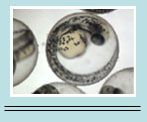

Home
Common Techniques
Classroom Experiments
Virtual Experiments
Games and Tutorials
Glossary
About This Site
Contact Us
ZFIN
Cite Us
How to mount zebrafish in glycerol
Glycerol is a viscous solution that helps hold the embryos in place, but still allows them to be moved into new positions to get pictures from different angles. Glycerol is typically used with bridged cover slips. NOTE: Glycerol is only used with fixed embryos.
Chemical safety: No hazards are listed for glycerol, and no protective gear is suggested, but you may want to wear gloves. If it comes in contact with your skin or eyes, wash the affected area with soap and copious amounts of water and inform instructor.
1. Fill one well of a nine-well glass histology dish with 50% glycerol (50:50 mixture of glycerol and Phosphate Buffered Saline (PBS)).

2. Fill another neighboring well with 100% glycerol.

3. Chose one or two fixed embryos that you want to view under the compound microscope. Pipette these embryos from the Petri dish into the 50% glycerol. Be careful and try not to allow too much water to enter the glycerol. Let the glycerol and zebrafish embryos sit for about 10 minutes.


4. Transfer the 50% glycerol and embryos to the 100% glycerol. Embryos can be stored in glycerol for long periods of time, as long as they are kept dark and at 4 degrees Celsius. Therefore, this is a good stopping point. If you don't have time to finish, transfer the embryos in glycerol to a 1.5 ml tube, and store in the refrigerator in the dark.


5. Pipette a small amount of glycerol into the middle of the well in your bridged cover slip. Pipette the embryo into the middle of the glycerol.

6. For mounting onto a bridged cover slip, you should visit “How to make a bridged cover slips.”